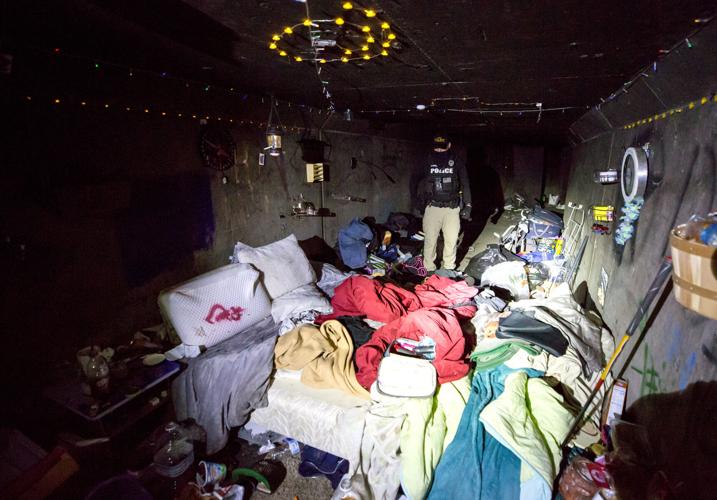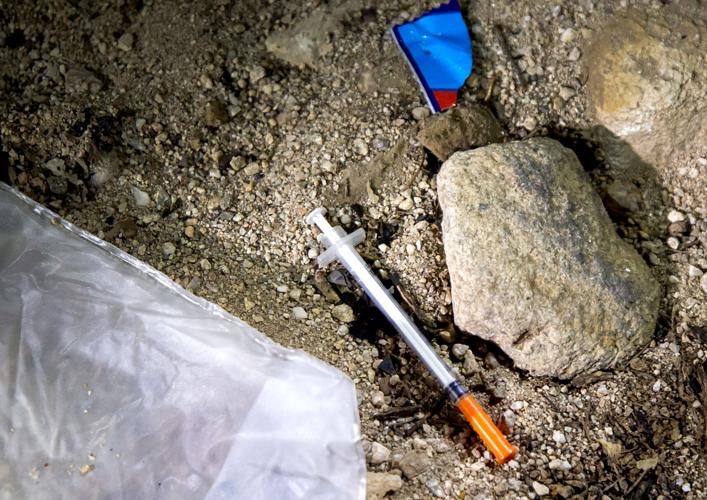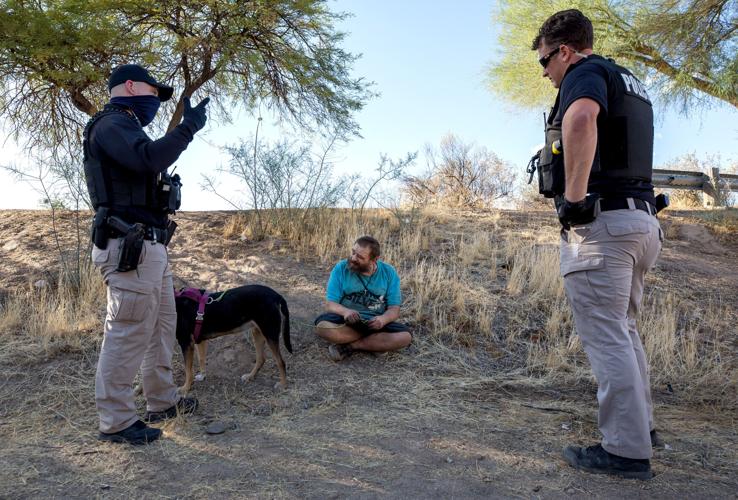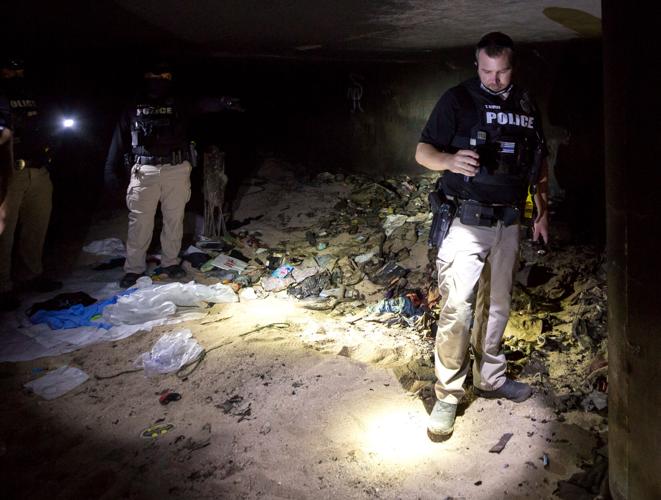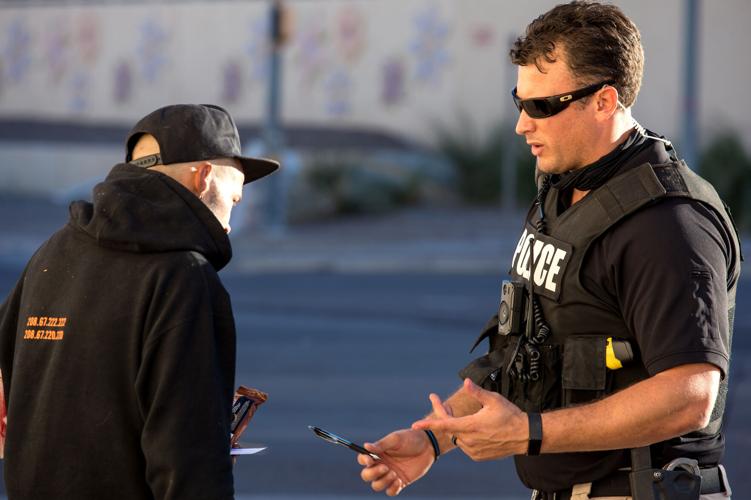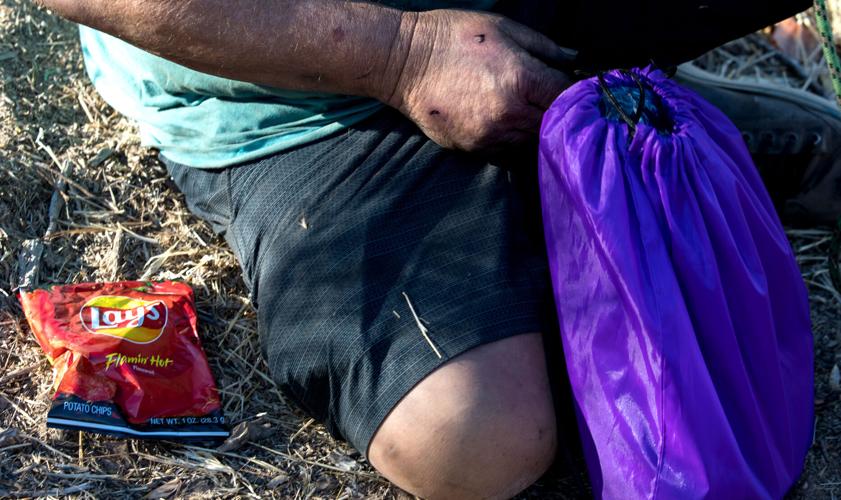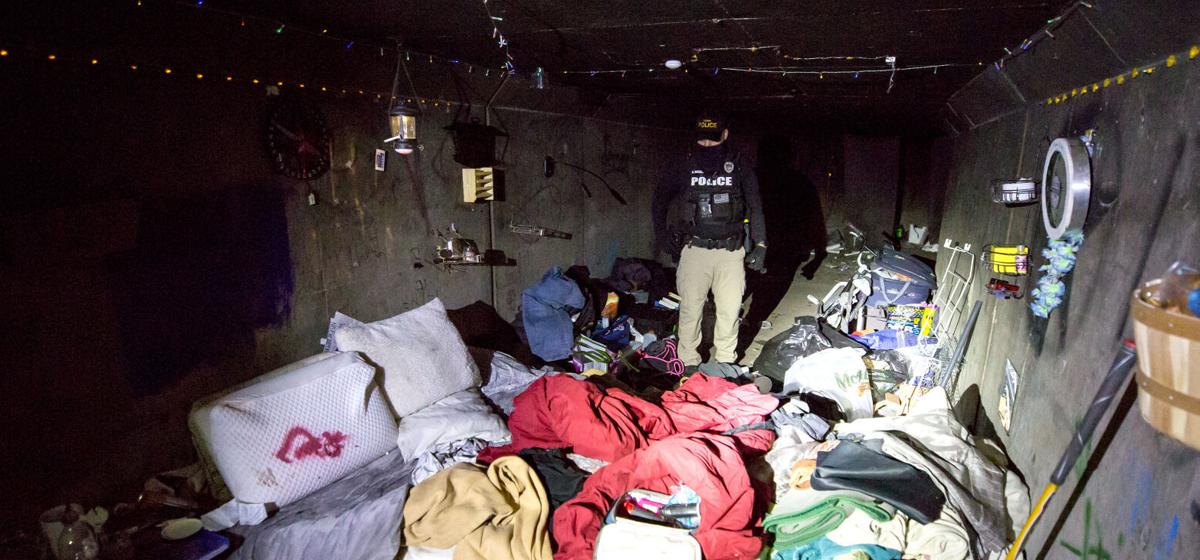Inside a mostly dark tunnel near Tucson Mall, a mattress sits against a wall, strings of multicolored Christmas lights taped above it.
A woven basket with fake flowers hangs on the wall, and a three-tiered plastic cubby holds a stuffed panda with big sparkly eyes and a blue alien plush toy from the animated Disney film “Lilo and Stitch.”
But scattered alongside this evidence of people trying to build stability with what they have are orange needle caps, a sign of drug misuse.

A syringe is left on the ground inside a Tucson tunnel — a common sight for officers who seek out drug users to apprise them of treatment options.
It’s a common sight for officers on the Tucson Police Department’s Substance Use Resource Team, whose goal is to get people with substance use disorder — many of whom are also facing homelessness and mental illness — into treatment and keep them out of jail.
The team is an extension of TPD’s Mental Health Support Team, which was created in 2014 to reach people with serious mental illness who weren’t getting the treatment they needed and sometimes became a danger to themselves or others.
When the opioid crisis grew in Southern Arizona, Tucson police used a similar model to implement an opioid-deflection program in 2018 as part of a Pima County project called United Medication Assisted Treatment Targeted Engagement Response, or U-MATTER.
The Substance Use Resource Team started with three officers from the mental health team who focused on substance use treatment and deflection along with their regular duties. By March 2020, the team was officially launched with six officers and a sergeant.
All Tucson police officers can refer someone to treatment instead of taking them to jail if they qualify for the program. Officers on the Substance Use Resource Team — along with peer support specialists through CODAC, a behavioral health facility — are able to spend more time educating people about community resources. They also provide transportation to detox facilities for people ready to take that step.
The department also has a Homeless Outreach Team, formed in February 2020. The Arizona Daily Star has spent time with all three teams in recent months through a reporting fellowship from Solutions Journalism Network.
Officers are trying to break the stigma
As the deflection program launched, every TPD officer went through a four-hour training by CODAC to learn the science behind substance use disorder.
Sgt. Ericka Stropka, who leads the substance use team and has been with the department more than 20 years, said she was skeptical when she first heard about the changes Assistant Police Chief Kevin Hall was making to address substance use problems differently. She said it took some destigmatizing for her to realize substance use was not a moral issue but rather a disease that requires medical treatment.
“It’s about giving a person the opportunity to actually heal themselves, heal their brain,” Stropka said.
This team of Tucson police officers is working to address the opioid crisis through treatment rather than punishment. As part of an Arizona Daily Star special project, here's a look at what this and other police units are doing to help keep community members out of jail.
Officers on her team change their approach as they go, continuously learning through refresher training sessions and through their experience connecting with people with substance use disorder.
Much of what the team does is educate users and their families about drug addiction as a disease, trying to break the stigma even people with substance use disorder have about addiction and about medication to treat opioid addiction, Stropka said.
Team members go to parks, washes, alleys and tunnels around the city, places they know people who use drugs tend to hang out. They also follow up after a 911 call involving possible overdose. Stropka reviews drug-related 911 calls once a week and sends officers out to do outreach and education either with the person who overdosed or with their roommates, friends or family members.
Officers carry naloxone, the opioid overdose reversal medication, and distribute it to people they connect with on the streets or during follow-up visits. When giving out naloxone kits, officers ask that the person listen for a couple minutes to learn how to inject it properly.

Officers Alex Russell, left, and Chris Ciarvella, both with the Police Department’s Substance Use Resource Team, talk with Daniel Helseo, a man experiencing homelessness who is struggling to get housing. Officers have been helping him for about a year.
The Pima County Health Department reported 337 overdose deaths in 2019 and 286 the two years prior. And the rate of fatal overdoses continues to rise, said Hall, the assistant police chief.
“Unfortunately, this past year is going to be over 400, which we’ve never seen before,” he said. “So we have a lot of work to do there.”
Team’s goal is to build community trust
About a year ago, the University of Arizona’s Southwest Institute for Research on Women joined the U-MATTER program to conduct research and provide data and feedback to the program’s partners.
The institute’s 18-month report shows that, between Nov. 1, 2018, and April 30, 2020, TPD officers tried using the deflection program to offer 1,044 people treatment instead of jail. In those cases, 322 people, or 30.8%, refused treatment and, 524 — or 50.2% — were immediately transported to a provider or hospital, the report says.
Thirty-two people agreed to go to treatment but were instead arrested because of a non-drug felony warrant or other charge such as domestic violence that made them ineligible for deflection.
The data encompass the deflection program in place across the entire Police Department, not just those on the substance use team.
In January, the team contacted 42 people through outreach and individual follow-ups and transported 12 to treatment. Josephine Korchmaros, the principal investigator of the U-MATTER program and a director and research professor with the Southwest Institute for Research on Women, said she considers that very successful, given the commitment a detox facility requires from the person agreeing to go, both in time and a desire to improve their life.

Officers carry naloxone, the opioid overdose reversal medication, and distribute it to people they connect with on Tucson’s streets or during follow-up visits.
Stropka tracks her team’s results. In 2020 members transported 143 people to treatment, 82 of whom may have otherwise gone to jail. They also followed up on 228 nonfatal overdose cases and 56 deflection cases.
The officers’ goal is to establish trust in the community and get as many people to treatment as possible, Stropka said. The team works not just with CODAC but also with other local treatment providers including Cornerstone, Community Medical Services and COPE. All those choices create more streamlined access to treatment, Stropka said.
“We’ve got a great community of behavioral health partners in that they really understand that for us to be able to really divert somebody from jail and into a treatment provider, whether it’s mental health or substance use or homelessness, it has to be easy for us,” she said.

Officer Travis Napier, right, who’s been with the Substance Use Resource Team for a year, and fellow officers check for people inside a north-side tunnel.
In the two years since the team was formed, officers have learned that not everyone will be ready for treatment when it’s offered. Some would rather be taken to jail, Stropka said.
It might take several attempts for someone to agree to get help. People might go to treatment and then relapse, but officers have seen people relapse then try again and stick with their treatment plan the second or third time around, Stropka said.
“So we don’t take it personally,” she said. “We just continue to be that conduit for effective change for people.”
‘I sincerely wanted to believe in myself’
The first time Antonio Martinez, 25, used methamphetamine five years ago, he was hooked.
About three years ago he spent a year in prison for drug possession after breaking his probation. He says going to prison didn’t help him and when he got out he got another drug-related charge.

Tucson police Officer Chris Ciarvella talks with a man at West Grant Road and Interstate 10 about treatment options available to him from CODAC.
“I had all the tools to get myself out. I just didn’t believe in myself,” he said.
When he met Officer Chris Ciarvella in January 2020, he was living on the streets and was not in contact with his family.
“I lost everything I had,” Martinez said. “I wasn’t trying anymore and I was just in a spot where I was literally in a hole and it would’ve taken for somebody to come reach their hand down there and say, ‘Hey, man, come on, let’s get out of here.’ But nobody knew I was in this hole.”
Ciarvella drove Martinez to jail, unable to deflect a felony warrant on his record. He deflected every charge he could to keep Martinez from going to prison and he and a peer support specialist visited Martinez in jail.
“Chris really blessed me with a friend who believed in me right off the bat,” Martinez said. “And I appreciated that so much, that I was able to show that I sincerely wanted to believe in myself, too.”
Martinez credits Ciarvella’s friendship with pulling him out of the “rock bottom” he kept hitting. Without recovery, he says, he was on his way to prison again.
“I did do it myself, I just didn’t do it by myself,” he said. “I will forever appreciate that and I will also forever remember how much that meant for me.”
After spending three months in jail, Martinez started his recovery. A few months later, he relapsed. Ciarvella kept looking for Martinez, and found out he had been booked into jail again.
Ciarvella said Martinez’s story is proof that people who fall into drug addiction need treatment, help and support.
“Prison and jail does not fix the problem,” Ciarvella said. “What fixes the problem is someone believing in you, telling you you’re worthwhile, telling you that you can do it and not giving up on you.”
Martinez wants to be able to help other people with substance use disorder, to show them he believes in them and they can believe in themselves.

Tucson police Officer Alex Russell talks to a man experiencing homelessness, who declined to give a name, about the different resources available to him.
Ciarvella said when he met him, he knew Martinez truly wanted help. After talking to him in jail for about an hour, Ciarvella said he was able to move past the drug misuse and see Martinez for the person he is. Now, Martinez calls Ciarvella for advice or just when he needs someone to talk to.
“He’s my friend and I want my friend to succeed,” Ciarvella said. “And I’m going to help my friend succeed in any way I possibly can.”
He’s been drug-free for six months now and says it’s been good to be his true self again and to be able to spend time with his family.
“I haven’t had a lonely recovery at all,” he said. “I had many people there supporting me. But it did start with one person and that was myself.”
The power of peer support
In November, Stropka, Ciarvella, two other team officers and Paul Payne, the peer support specialist, visited washes and tunnels near the Tucson Mall.
In a wash near West Wetmore Road and North Stone Avenue, officers separated three men to tell them about the resources available to them.

Daniel Helseo, a man struggling to get housing, holds on to a “go bag” given to him by a Substance Use Resource Team officer.
Separating groups lets officers connect one-on-one without someone being influenced by their buddies or feeling judged if they accept help, Ciarvella said.
The officers often start by informing people they are trespassing. They used to approach people in parks, but found that people feel more obligated to stay and listen if they’re already committing a crime. The goal isn’t to arrest anyone, so the trespassing charges are usually dropped.
After Payne talked with one of the men, he agreed to go to CODAC for treatment.
While Payne transported the man to CODAC, the officers stayed behind to teach the other two men how to use naloxone. They left their contact information and other resources in case the men changed their minds and decided they wanted to seek treatment.
Someone who’s not ready today might be ready a day or a week later, the officers said.
County looking for new funding to sustain peers
Payne is sometimes able to better connect with people because he’s been in their shoes.
As someone in recovery, and after spending 11 years in prison, he’s one of three co-responder peer support specialists with the team.

Tucson police Officer Alex Russell, who’s been with the Substance Use Resource Team for under a year, looks inside a tunnel near the southeast corner of North Stone Avenue and East Wetmore Road. The officers often find decorations and personal items that add a “home” touch to the tunnels, said Officer Chris Ciarvella.
When he got out of prison in 2005, Payne worked several retail and service industry jobs. He said he didn’t think anyone would want to hire him, and he never thought he would have a job working with police.
“I think the weirdest part is having 15 cops’ phone numbers on my phone,” he said. “That’s weird. My daughter FaceTimes them.”
Dan Barden, director at CODAC, said the peer support specialists being able to connect with people they’re trying to help makes people more willing to listen. Even if they don’t agree to go into treatment at the moment, officers and peer specialists may plant a seed in a person’s mind, Barden said.
The CODAC peer support specialists are paid through a $1.4 million grant from the U.S. Department of Health and Human Services, which is set to expire in September. The Pima County Criminal Justice Reform Unit, the Tucson Police Department and CODAC are looking for grants to sustain funding for those peer support positions.
“Sustainability, it’s been a discussion all the way along,” Barden said. “We always knew this day would come where three years would end and if you have a program that’s successful we want this program to be able to continue.”
The U-MATTER program partners are looking into potential grants or to the Arizona Criminal Justice Commission for funding to sustain the program, he said. They are also talking to AHCCCS, Arizona’s medicaid agency, about funding because a lot of the people that receive treatment have or qualify for medicaid, Barden said.
Ciarvella sees the program’s success every day. He said being on the Substance Use Resource Team has made him more emotionally attached to the people he serves. Part of the job is asking people what happened to them, and putting himself in their shoes to better understand.
“It starts to weigh on you heavily,” he said. “And you start to picture losing your own kids and having your family kick you out and, just think, your life is literally one square mile every day, waking up trying to find drugs.”
He said caring is also what makes the team effective in getting people to trust them and getting people to treatment.
“If you’re doing this job right,” he said, “it’ll break your heart.”
Homeless Outreach Teams with the city and the police department respond to calls about camps and connect people e with resources including per…


